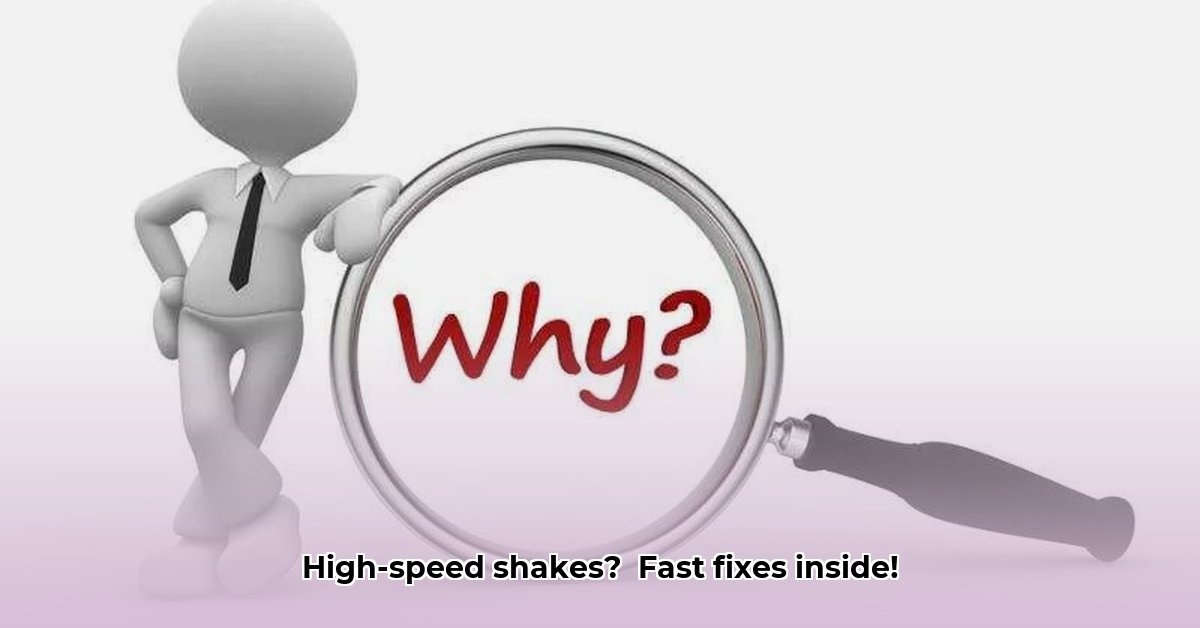That scary shaking in your car when you’re speeding down the highway? Don’t panic! It’s a more common problem than you think and often has a pretty simple fix. This guide will walk you through figuring out what’s causing the shake, step-by-step, so you can get back to driving smoothly and safely. We’ll cover everything from easy checks you can do yourself (like tire pressure!), to when it’s time to call in a professional. We’ll even give you tips to prevent this from happening again. So, let’s figure out what’s making your car vibrate and get you back on the road with confidence. For more serious engine issues, problems like a bad throttle sensor can also cause vibrations; check out this helpful guide.
Why Does My Car Shake at High Speeds? Common Causes and Solutions
That unsettling shimmy your car does when you hit the highway? It’s more common than you might think and usually fixable. Let’s figure out what’s going on and get you back on the road smoothly.
Feeling the Shake: Identifying Vibration Issues
Before we dive into solutions, let’s get a clear picture of the problem. When does the shaking start? Is it a gentle quiver that begins around 60 mph, or a full-blown shudder that kicks in only at higher speeds, say 70 mph or more? Does it happen only when you’re accelerating, decelerating, or is it a constant tremor? Pay close attention to where you feel the vibration – is it mainly in the steering wheel, or does the whole car seem to be trembling? Does the vibration change when you turn the steering wheel? Are there any accompanying noises like grinding, humming, clicking, or a rhythmic thumping? These little details are incredibly helpful in figuring out what’s wrong. Observing these telltale signs correctly provides insight into the root cause of car vibration.
The Usual Suspects: Common Causes of High-Speed Shakes
Several parts of your car can be behind that annoying shake. Let’s explore the most likely culprits.
1. Tires: The Balancing Act
Think of your tires as spinning tops. Perfectly balanced ones spin smoothly. But if they’re out of whack—whether from uneven wear, damage (like a bulge or sidewall bubble), or simply being unbalanced—they’ll wobble, transferring that wobble to your steering wheel and the rest of your car. This is often the most common reason for high-speed shaking. A damaged tire, maybe with a bulge or uneven wear, will create a similar vibration.
2. Wheel Alignment: Staying Straight and True
Even if your tires are perfectly balanced, if your wheels aren’t properly aligned, it can cause vibrations. Misalignment means your tires aren’t pointing in the same direction, leading to uneven wear and shaking, especially at higher speeds. Hitting a pothole or curb can easily knock your wheels out of alignment.
3. Low Tire Pressure: A Soft Ride Gone Wrong
Under-inflated tires deform at higher speeds, causing irregular contact with the road and a noticeable shake. Your tires are like balloons; not enough air, and they’ll flex and wobble. Always check your tire pressure using a reliable gauge; the correct pressure is specified on a sticker inside your driver’s side doorjamb or in your car’s owner’s manual. Maintaining proper tire pressure can improve fuel efficiency by up to 3% and extend the life of your tires.
4. Wheel Bearings: The Silent Support System
Wheel bearings are the unsung heroes of smooth driving. They allow your wheels to rotate freely with minimal friction. If they’re worn, tired, or damaged, you’ll feel a vibration—often with a low hum or growl that gets louder as your speed increases. It’s like listening to a slightly off-key record that increases in volume. You might also notice a clicking or snapping sound when turning.
5. CV Joints: Turning Smoothly (or Not)
Constant Velocity (CV) joints are what let your drive shafts send power to the wheels even when you’re turning. If these wear out or their protective boots are torn, allowing dirt and debris to enter, you’ll likely feel shaking, especially when accelerating or turning. You might also hear clicking or popping—kind of like tiny explosions in your wheels.
6. Suspension System: Shocks and Struts That Are…Not
Worn-out shocks, struts, ball joints, tie rod ends, or other suspension components can make your car unstable at high speeds. This typically feels like a general shaking or bouncing, or a feeling of looseness in the steering. It’s like driving on a really bumpy road, even when it’s smooth. Proper suspension is key to vehicle stability and handling.
7. Brake Rotors: Warped or Worn
If you feel the shaking primarily when braking, especially a pulsating sensation in the brake pedal or steering wheel, warped or worn brake rotors are a likely cause. Over time, brake rotors can become uneven due to heat and friction.
8. Loose Lug Nuts: A Simple but Serious Problem
Sometimes, the simplest things are the most overlooked. Loose lug nuts, which secure your wheels to the car, can cause significant vibrations. This is especially common after having your tires changed. Always double-check that your lug nuts are properly tightened.
9. Drivetrain Drama: Deeper Issues
Sometimes, the problem lies deeper within the drivetrain—the system transferring power from the engine to the wheels. Issues with the differential, axles, or other components can cause vibrations that worsen at higher speeds. This is less common, but it’s usually more serious and requires professional diagnosis. A bent axle can also cause vibrations.
Troubleshooting: A Step-by-Step Approach
Let’s tackle this systematically.
Step 1: The Visual Checkup
Start with the easiest things. Carefully inspect your tires and wheels. Look for any obvious signs of damage, like bulges, uneven wear, sidewall bubbles, or anything that just looks “off.” Check your wheels for any bends or dents.
Step 2: Tire Pressure – The Air Check
Grab your trusty tire pressure gauge and check the inflation in each tire (consult your owner’s manual or the sticker on your doorjamb for the correct pressure). Low pressure is a common culprit.
Step 3: The Lug Nut Check
Use a lug wrench to ensure all the lug nuts on each wheel are properly tightened. Consult your owner’s manual for the correct torque specifications.
Step 4: The Test Drive – Feel and Listen
Take a careful test drive, paying close attention to when and where the shaking occurs. Does the vibration change with speed or acceleration? Does it happen when braking or turning? Listen carefully for any extra noises (humming, grinding, clicking).
Step 5: Seek Expert Advice
If the shaking persists after checking tire pressure, visually inspecting tires, and tightening lug nuts, or if you hear unusual noises, it’s time to call in the professionals. Don’t ignore persistent vibrations; your safety is important.
When to Bring in the Mechanic: Knowing Your Limits
If the simple checks don’t solve the issue, or if you’re hearing alarming noises (like loud grinding or banging), or you just feel uncomfortable driving your car, go see a trusted mechanic. Delaying fixing a significant vibration could lead to larger (and more expensive!) problems down the road, and it can compromise your safety.
Preventative Maintenance: Keeping Things Smooth
Regular maintenance is your best friend. Follow your owner’s manual recommendations for tire rotations, balancing, and alignments. Keeping up with checks of your suspension and drivetrain can head off problems before they become major headaches — and expenses! Regular maintenance prevents costly car repairs.
Troubleshooting Table: A Quick Summary
| Symptom | Possible Cause(s) | Severity | Next Steps |
|---|---|---|---|
| Steering wheel shake | Tire imbalance, worn tires, misalignment | Low-Medium | Tire rotation, balancing, alignment, pressure check |
| Whole car shake | Worn wheel bearings, suspension issues, drivetrain issues | Medium-High | Professional inspection |
| Humming/growling | Worn wheel bearings | Medium-High | Immediate professional inspection |
| Clicking/popping sounds | Damaged CV joints | Medium-High | Immediate professional inspection |
| Pulsating during braking | Warped brake rotors | Medium | Brake rotor inspection/replacement |
Remember, a shaking car isn’t just annoying; it can be a safety hazard. Tackling this issue promptly keeps you, your passengers, and your wallet safe and sound.
How to Diagnose Car Shaking Between 60-80 mph Beyond Tire Issues
Have you ever felt that unsettling wobble in your car as you hit highway speeds? That unnerving shake between 60 and 80 mph? It’s more common than you think, and while tires are often the culprit, there are other potential causes. Let’s explore how to pinpoint the problem.
Identifying the Vibration
First, observe the shaking carefully. Where do you feel it most strongly? Is it a constant tremor, or does it intensify during acceleration, deceleration, or braking? Note the speed range and any accompanying noises (grinding, humming, clicking, etc.). Does the vibration change when you turn the steering wheel? The more detail you gather
- Why an App Appeared on My Phone Unexpectedly - November 22, 2025
- How to Stop Unwanted Apps from Automatically Downloading on Android - November 21, 2025
- Why Are Android Games Installing Themselves on Your Phone? - November 20, 2025










